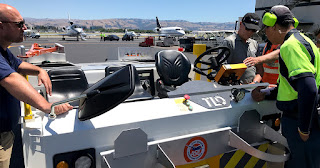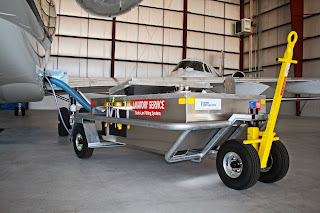How Risk Reduction Can Equal Cost Reduction for an Airside Ground Crew
New risk reduction strategies and safety measures are often met with
some trepidation. They can be considered an inconvenient disruption
cluttering up the works. Industry changes, new statutes, regulations,
and technological updates, however, mean that those changes are
inevitable. When done right, risk reduction and safety updates, from
upgrades to your aircraft tug
fleet to more efficient crew conduct, can mean improved performance and
therefore lower costs. There’s no reason to dread safety updates if an
operation is properly prepared to roll them out.
GSE Organization Improves Everything
One of the most important areas in which an airside ground crew can improve safety and lower cost, significantly when done right, is by organizing the scheduling and use of ground support equipment (GSE). An increasingly popular method for doing so is by linking, tracking, and scheduling GSE vehicles with modern telematics systems.
An accompanying strategy, often used in conjunction with telematics, is implementing a GSE pooling program. Alone and in combination, telematics and pooling are yielding risk reduction and performance results at airports all around the world. Some advantages include more efficient fuel use, less vehicle running time, lower risk of damage to aircraft, less vehicle congestion on the apron, and more accurate maintenance schedules. When implemented correctly, these strategies can help reduce costs and the risk of accidents.
Updated GSE Technology Lowers Risk
Organization is one facet of safety and risk management, but the technology in the tools and vehicles themselves also needs to be updated. For instance, there are safety systems that, when installed on an aircraft pushback or tug fleet, can improve operational safety considerably.
For example, the SiPsHitch™ Linear Force Monitoring System from AERO Specialties is a safety system that monitors and records force applied while towing and warns operators of overstress damage before it occurs. Additionally, the TLD Aircraft Safe Docking system prevents GSE from approaching aircraft too quickly, automatically preventing collision damage. Along with the considerable savings resulting from avoiding expensive collisions, installing these safety systems improves the working environment for ground crews.
Safe Crew Should Always Be a Priority
There’s an additional, far more serious risk accompanying collisions and other GSE accidents and incidents—that ground crew, airline personnel, or passengers are injured. The risk of injury alone is sufficient to implement all possible safety measures, and it’s usually the reason for mandatory upgrades. Further exacerbating that worse-case scenario is the considerable cost accompanying any injury. Possible expenses include lost labor, workers’ compensation, insurance premiums, and potential litigation. It’s a combination that’s more than sufficient to justify emphasizing ground crew safety measures.
Those measures include basic steps that can be overlooked or allowed to lapse, like neglecting to insist on appropriate training or allowing crew to operate GSE they’re not licensed or certified to operate. Training should also include familiarizing ground crew with any new safety systems, emergency protocols, and lines of communication.
About AERO Specialties
AERO Specialties is an industry-leading aviation ground support equipment (GSE) provider offering GSE that’s well-known for optimized performance, safety, and reliability. Their customers, both civilian and military, at corporate airports, FBOs, or private airports, rely on AERO Specialties for the highest quality GSE, new, used, and refurbished. As an additional assurance of excellence, AERO Specialties trains each one of the members of their team, familiarizing them thoroughly with every piece of GSE they offer. That means whatever GSE you need, from a powerful, safe aircraft ground power unit, to a set of multicolored LED marshalling wands, you can trust AERO Specialties.
Take your aviation business to greater heights with GSE from AERO Specialties, at Aerospecialties.com
 |
| Aircraft Ground Power Unit |
GSE Organization Improves Everything
One of the most important areas in which an airside ground crew can improve safety and lower cost, significantly when done right, is by organizing the scheduling and use of ground support equipment (GSE). An increasingly popular method for doing so is by linking, tracking, and scheduling GSE vehicles with modern telematics systems.
An accompanying strategy, often used in conjunction with telematics, is implementing a GSE pooling program. Alone and in combination, telematics and pooling are yielding risk reduction and performance results at airports all around the world. Some advantages include more efficient fuel use, less vehicle running time, lower risk of damage to aircraft, less vehicle congestion on the apron, and more accurate maintenance schedules. When implemented correctly, these strategies can help reduce costs and the risk of accidents.
Updated GSE Technology Lowers Risk
Organization is one facet of safety and risk management, but the technology in the tools and vehicles themselves also needs to be updated. For instance, there are safety systems that, when installed on an aircraft pushback or tug fleet, can improve operational safety considerably.
For example, the SiPsHitch™ Linear Force Monitoring System from AERO Specialties is a safety system that monitors and records force applied while towing and warns operators of overstress damage before it occurs. Additionally, the TLD Aircraft Safe Docking system prevents GSE from approaching aircraft too quickly, automatically preventing collision damage. Along with the considerable savings resulting from avoiding expensive collisions, installing these safety systems improves the working environment for ground crews.
Safe Crew Should Always Be a Priority
There’s an additional, far more serious risk accompanying collisions and other GSE accidents and incidents—that ground crew, airline personnel, or passengers are injured. The risk of injury alone is sufficient to implement all possible safety measures, and it’s usually the reason for mandatory upgrades. Further exacerbating that worse-case scenario is the considerable cost accompanying any injury. Possible expenses include lost labor, workers’ compensation, insurance premiums, and potential litigation. It’s a combination that’s more than sufficient to justify emphasizing ground crew safety measures.
Those measures include basic steps that can be overlooked or allowed to lapse, like neglecting to insist on appropriate training or allowing crew to operate GSE they’re not licensed or certified to operate. Training should also include familiarizing ground crew with any new safety systems, emergency protocols, and lines of communication.
About AERO Specialties
AERO Specialties is an industry-leading aviation ground support equipment (GSE) provider offering GSE that’s well-known for optimized performance, safety, and reliability. Their customers, both civilian and military, at corporate airports, FBOs, or private airports, rely on AERO Specialties for the highest quality GSE, new, used, and refurbished. As an additional assurance of excellence, AERO Specialties trains each one of the members of their team, familiarizing them thoroughly with every piece of GSE they offer. That means whatever GSE you need, from a powerful, safe aircraft ground power unit, to a set of multicolored LED marshalling wands, you can trust AERO Specialties.
Take your aviation business to greater heights with GSE from AERO Specialties, at Aerospecialties.com



Comments
Post a Comment